Cultural Heritage
What is cultural heritage?
Cultural heritage means cultural assets worth being preserved. In a broad sense, it includes not only tangible properties but includes both a variety of artistic activities passed down on from generation to generation and the essence of ethnic or national constitution such as civilization heritage, folklore, laws, habits, and lifestyles.
Types
Cultural heritage is largely divided into the two categories: “designated cultural heritage” protected by the Cultural Properties Protection Law or municipal ordinance of the competent City/Do with regard to cultural heritage protection, and “non-designated cultural heritage” not protected by laws but in need of steady protection and preservation among cultural heritage.
Types of designated cultural heritage
| by designator/type | Tangible cultural properties | Folklore resources | Monuments | Intangible cultural heritage | |||
|---|---|---|---|---|---|---|---|
| State-designated cultural heritage | National treasures | Treasures | Important folk cultural heritage | Historic sites | Scenic sites | Natural monuments | Important intangible cultural heritage |
| City/Do-designated cultural heritage | Local tangible cultural heritage | Local folklore resources | Local monuments | Local intangible cultural heritage | |||
| Cultural heritage resources | |||||||
State-designated cultural heritage
The Administrator of the Cultural Heritage Administration of Korea is responsible for the classification of important cultural heritage designated through the deliberation of the Cultural Heritage Committee in accordance with the Cultural Properties Protection Law into seven types: national treasures, treasures, important intangible cultural heritage, historic sites, scenic sites, natural monuments, and important folklore resources.
| National treasures | Among all our treasures, the following are considered rare and highly valuable from the perspective of human civilization - Sungnyemun Gate in Seoul, Hunminjeongeum Manuscript, etc. |
|---|---|
| Treasures | These are considered important among tangible cultural heritage such as structures, documents, books, ancient documents, paintings, sculptures, crafts, archeological specimens, weapons, and more - Heunginjimun Gate in Seoul, Daedong yeojido (Map of the Great East), etc. |
| Historic sites | These are considered crucial including ruins, ancestral rites, religions, politics, national defense, industry, transportation, civil engineering achievements, education, social work, tombs, and tomb stones - examples are Suwon Hwaseong Fortress, Poseokjeong Pavilion Site, Gyeongju, and more. |
| Scenic sites | Among monuments, these are considered as important historic sites or picturesque places - Sogeumgang River, Cheonghakdong Village, Myeongju, and Sangbaekdo and Habaekdo Islands |
| Natural monuments | Among all the monuments, the following are considered important animals (habitat, breeding places, sanctuaries included), plants (natural habitat included), and geology/minerals - Dalseong Thuja Forest and the Chinese Egret. |
| Important intangible cultural heritage | Intangible cultural works of outstanding historic, artistic, or academic value, such as a dramas, music, dance, craft skills, etc.:royal ancestral rites music, Yangju Byeolsandae Nori - royal ancestral rites music, Yangju Byeolsandae Nori (Mask Dance Drama of Yangju), and more. |
| Important folklore resources | Such resources include food, clothing, housing, production, livelihood, transportation, means of conveyance, communications, trade, social life, folkloric religion/ shamanism, artistic talents, entertainment, plays, and more. |
City/Do-designated cultural heritage
Special Metropolitan City Mayor, Metropolitan City Mayor, or Do Governor (hereinafter “Mayor/Do Governor”) may designate, as City/Do-designated cultural heritage, cultural heritage deemed worthy of preservation in accordance with the municipal ordinance of the competent City/Do, among those under his/her jurisdiction which are not designated as State-designated cultural heritage.It is divided into four categories.
| Tangiblecultural heritage | Tangible cultural works of outstanding historic, artistic, or academic value, such as structures, records, books, ancient documents, paintings, sculptures, artifacts, etc., and other archeological resources similar thereto |
|---|---|
| Intangible cultural heritage | Intangible cultural works of outstanding historic, artistic, or academic value, such as a drama, music, dance, craft skills, etc. |
| Monuments | Historic sites such as shell mounds, ancient tombs, fortress ruins, old palace ruins, kiln sites, relic-containing strata of outstanding historic or academic value; scenic sites with outstanding artistic value and excellent scenic view;and animals (habitat, breeding grounds, sanctuaries included), plants (natural habitat included), minerals, and caves of outstanding historic, scenic, or academic value |
| Folklore resources | Customs or traditions related to food, clothing, housing, trades, religion, annual observances, etc., and clothing, implements, houses, etc. used therefor which are essential for understanding changes to the life of nationals |
Cultural heritage resources
These are designated by the Mayor/Do Governor in accordance with the municipal ordinance of the competent City/Do among cultural heritage not designated as City/Do-designated cultural heritage but deemed necessary for preservation of folk culture.
Registered cultural heritage
The Administrator of the Cultural Heritage Administration may register certain cultural heritage for which measures for preservation and utilization are specifically required, among those which were constructed, manufactured, and formed more than 50 years ago and fall under either of the following other than designated cultural heritage, following deliberation by the Cultural Heritage Committee in accordance with Chapter V, Article 53 of the Cultural Properties Protection Law. (Even if those less than 50 years old need to be urgently protected, however, they may be registered as registered cultural heritage.)
- For instance, Namdaemun-ro, the company building of Korea Electric Power Corporation (Registration No. 1), the Labor Party Office, Cheorwon (Registration No. 22), The Locomotive at Jangdan Station of Gyeongui-Line (Registration No. 78), a set of blood-stained clothes of Kim Gu (Registration No. 439), and more.
| Concept and scope of the modern cultural heritage |
A thing that is commemorative with highly symbolic value in diverse fields such as history, culture, arts, society, economy, religion, and life. |
|---|---|
| A thing that has an historical and cultural background in the region and whose value is widely known to the public. | |
| A thing that has important value in reflecting or understanding the specific historical periods such as technical development or artistic trends. |
Non-designated cultural heritage
These are not designated according to the Cultural Properties Protection Law or municipal ordinance of the competent City/Dobut deemed worth being preserved.
| Ordinary movable cultural heritage (Article 60 of the Cultural Properties Protection Law) |
These are worth being preserved, from historical and artistic perspectives, among non-designated movable cultural heritage that falls under application mutatis mutandis of prohibiting exportation or carrying out such as documents, books, wooden printing blocks, paintings, sculpture, crafts, archeological specimens and folklore resources. |
|---|---|
| Buried cultural heritage (Article 2 of Acton Protection and Inspection of Buried Cultural Heritage) |
- Tangible cultural heritage buried or distributed underground or underwater - Tangible cultural heritage contained in the structures, etc. -Natural caves and fossils formed and deposited on the ground’s surface, underground or underwater (including seas, lakes and rivers), and others deemed to have outstanding geological values as prescribed by Presidential Decree. |
A list of designated (registered) cultural heritage in Busan Metropolitan City
| Total | State-designated cultural heritage | City-designated cultural heritage | Remark | |||||||||||
|---|---|---|---|---|---|---|---|---|---|---|---|---|---|---|
| Subtotal | Treasure | Historic site | Natural monument |
Intangible cultural heritage |
Important folklore resources |
Registered cultural heritage |
Subtotal | Tangible cultural heritage |
Intangible cultural heritage |
Monuments | Folklore resources |
Cultural materials |
||
| 93 | 16 | 10 | 1 | 1 | 1 | 1 | 2 | 77 | 47 | 1 | 3 | 1 | 25 | |
State-designated cultural heritage
Treasure (寶物) - 10
| Serial number | Name of cultural heritage | Designation number | Designation date | Period | Location |
|---|---|---|---|---|---|
| 1 | Three-story Stone Pagoda of Beomeosa Temple, Busan | No. 250 | 63.01.21 | United Silla period | Beomeosa Temple, 250, Beomeosa-ro |
| 2 | Samguk Yusa (Memorabilia of the Three Kingdoms), Volumes4 and 5 | No. 419-3 | 02.10.19 | Early Joseonperiod | |
| 3 | Daeungjeon Hall of Beomeosa Temple, Busan | No. 434 | 66.02.28 | Joseon period | |
| 4 | Annotated Brahmajala Sutra (The Sutra of Brahma’s Net) | No. 894-2 | 07.09.18 | Late Goryeo period | |
| 5 | Buljo samgyeong (The Three Sutras) | No.1224-2 | 07.09.18 | Late Goryeo period | |
| 6 | Jogyemun Gate of Beomeosa Temple, Busan | No.1461 | 06.02.07 | 17th century | |
| 7 | Geumjang yojipgyeong (Collection of the Essentials of Sutras), Volumes 1 and 2 | No. 1525 | 07.09.18 | Late Goryeo period to early Joseon period | |
| 8 | Wooden Seated Sakyamuni Buddha Triad of Beomeosa Temple, Busan | No. 1526 | 07.09.18 | 1661 | |
| 9 | Mokjang jido (Maps of Ranches) | No. 1595-2 | 08.12.22 | 1678 | Pusan National University Library, 2, Busandaehak-ro 63beon-gil |
| 10 | Busan Gukcheongsa Bronze Drum (釜山 國淸寺 靑銅金鼓) |
No. 1733 | 11.12.23 | 1666 | 42, Bukmun-ro (entrusted to the Beomeosa Museum for storage) |
Historic Site - 1
| Name of cultural heritage | Designation number | Designation date | Period | Location |
|---|---|---|---|---|
| Geumjeongsanseong Fortress, Busan | No. 215 | 71.02.09 | Late Joseon period | Across Geumseong-dong |
Natural monument - 1
| Name of cultural heritage | Designation number | Designation date | Period | Location |
|---|---|---|---|---|
| Wisteria Habitat of Beomeosa Temple, Busan | No. 176 | 66.01.13 | Approx. 120 years | Beomeosa Temple, 250, Beomeosa-ro |
Important intangible cultural heritage - 1
| Name of cultural heritage | Designation number | Designation date | Period | Location |
|---|---|---|---|---|
| Jasujang (Embroidery) | No. 80 | 96.12.10 | Embroidery | 50, 4793, Jungang-daero, Geumjeong-gu |
Important folk cultural heritage (重要民俗文化財) - 1
| Name of cultural heritage | Designation number | Designation date | Period | Location |
|---|---|---|---|---|
| Uiwang Won Yu-gwan | No. 274 | 13.06.14 | 1900 | 106-1, Oryun-daero Oryundae Korean Martyrs Museum |
Registered cultural heritage(登錄文化財) - 2
| Name of cultural heritage | Designation number | Designation date | Period | Location |
|---|---|---|---|---|
| Formal main building of Pusan National University | No. 641 | 14.10.30 | 1959 | Pusan National University, 2, Busandaehak-ro 63beon-gil |
| PNU Rainbow Gate and former security office | No. 642 | 14.10.30 | 1957 | Pusan National University, 2, Busandaehak-ro 63beon-gil |
Busan Metropolitan City-designated cultural heritage
Tangiblecultural heritage(有形文化財) - 47
| Serial number | Name of cultural heritage | Designation number | Designation date | Period | Location |
|---|---|---|---|---|---|
| 1 | Five-story Stone Pagoda | No. 9 | 72.06.26 | Late Silla period to early Goryeo period | Pusan National University Museum, 2, Busandaehak-ro 63beon-gil |
| 2 | Three-story Pagoda at the East of Wonhyoam Temple | No. 11 | 72.06.26 | Late Silla period to early Goryeo period | Wonhyoam Hermitage, 256, Beomeosa-ro |
| 3 | Three-story Pagoda at the West of Wonhyoam Temple | No. 12 | 72.06.26 | Late Silla period to Early Goryeo period | |
| 4 | Flagpole Support of Beomeosa Temple | No. 15 | 72.06.26 | United Silla period | Beomeosa Temple, 250, Beomeosa-ro |
| 5 | Stone Lantern of Beomeosa Temple | No. 16 | 72.06.26 | United Silla period | |
| 6 | Fretted Woodblock with a Poet of Cheongryongam Temple of Beomeosa Temple | No. 25 | 99.09.03 | Joseon period | |
| 7 | Fretted Woodblock With Cheonsugyeong of Beomeosa Temple | No. 26 | 99.09.03 | 1676 | |
| 8 | Fretted Woodblock with Eosanjip of Beomeosa Temple | No. 27 | 99.09.03 | 1700 | |
| 9 | Fretted Woodblock with Record of Beomeosa Temple's History | No. 28 | 99.09.03 | Joseon period | |
| 10 | Fretted Woodblock with Seonmunchwalyo of Beomeosa Temple | No. 29 | 99.09.03 | 1908 | |
| 11 | Fretted Woodblock with Kwonwangmun(Eonmun) | No. 30 | 99.09.03 | 1908 | |
| 12 | Jusimgyeong by Taejeonhwasang in Beomeosa Temple | No. 32 | 99.11.19 | 1411 | |
| 13 | Hamheo Quotation | No. 33 | 99.11.19 | 1440 | |
| 14 | Jikji by Jigong of Beomeosa Temple | No. 34 | 99.11.19 | 1475 | |
| 15 | Seonjongyeongajip | No. 35 | 99.11.19 | 1542 | |
| 16 | Bumoeunjunggyeong | No. 36 | 99.11.19 | 1562 | |
| 17 | Beoppodangyeong | No. 37 | 99.11.19 | 1569 | |
| 18 | Illustration of the Vajracchedika Prajnaparamita Sutra | No. 38 | 99.11.19 | 1570 | |
| 19 | Buljoyeokdaetongjae | No. 39 | 99.11.19 | 1576 | |
| 20 | Mongsanhwasang beobeo yangnok (Sermons of Buddhist Monk Mongsan with Commentaries in Korean) | No. 40 | 99.11.19 | 1579 | |
| 21 | Saddharmapundarika Sutra (The Lotus Sutra) of Beomeosa Temple | No. 41 | 99.11.19 | Joseon period | |
| 22 | Guardian of the East of Beomeosa | No. 51 | 03.09.16 | 1869 | |
| 23 | Guardian Paintong of Beomeosa Temple | No. 52 | 03.09.16 | 1817 | |
| 24 | Portrait of Goddess of Mercy in White of Beomeosa Temple Gwaneum Hall | No. 53 | 03.09.16 | 1882 | |
| 25 | Portrait of Great Master Uisang of Beomeosa | No. 55 | 03.09.16 | 1767 | |
| 26 | Palsangjeon Hall and Dokseongseongjeon Hall and Nahanjeon Hall of Beomeosa Temple | No. 63 | 06.07.03 | 1906 | |
| 27 | Sakyamuni Platform Painting, Main Buddha Hall of Beomeosa | No. 67 | 06.11.25 | 1882 | |
| 28 | Tripitaka Painting, Main Buddha Hall of Beomeosa | No. 68 | 06.11.25 | 1882 | |
| 29 | Guardian Painting, Main Buddha Hall of Beomeosa Temple | No. 69 | 06.11.25 | 1882 | |
| 30 | Seated Wooden Avalokitesvara Statue of Beomeosa Temple | No. 70 | 06.11.25 | 1722 | |
| 31 | Seated Wooden Vairocana Statue of Beomeosa Temple | No. 71 | 06.11.25 | 17th-18th century | |
| 32 | Seated Wooden Buddha Statue of Beomeosa Temple | No. 72 | 06.11.25 | 17th-18th century | |
| 33 | The Lotus Pedestal of Beomeosa Temple | No. 73 | 06.11.25 | Late United Silla period to early Goryeo period | |
| 34 | Bulseol jangsu myeoljoe hojedongja daranigyeong | No. 76 | 07.09.07 | 16th century | Geumjeong Middle School, 2104, Jungang-daero |
| 35 | Vajracchedika prajnaparamita Sutra (The Diamond Sutra) | No. 80 | 07.09.07 | 1415 | Beomeosa Temple, 250, Beomeosa-ro |
| 36 | Bodhidharma Four Act theory of Beomeosa | No. 81 | 07.09.07 | 14th century | |
| 37 | Seonmunyeomsongjip of Beomeosa | No. 82 | 07.09.07 | 14th century | |
| 38 | Bronze Buddhist Temple Bell of Beomeosa Temple | No. 90 | 08.09.11 | 1728 | |
| 39 | Seated Wooden Avalokitesvara Statue of Beomeosa Temple | No. 96 | 08.12.16 | 18th century | Wonhyosam Hermitage, 256, Beomeosa-ro |
| 40 | Lotus Flower in Geumcheonseonwon Zen Center | No. 130 | 13.10.23 | 1477 | Geumcheonseonwon, 271, Geumsaem-ro |
| 41 | Maheungmokcheo Sinbanjinssi Grinding Stone | No. 136 | 14.01.22 | 1467 | Pusan National University Museum, 2, Busandaehak-ro 63beon-gil |
| 42 | Seated Stone Avalokitesvara Statue at Sajaam Hermitage of Beomeosa Temple | No. 139 | 14.03.19 | 1904 | Sajaam Hermitage, 26, Sangma 1-gil, Geumjeong-gu |
| 43 | Painting of Amitabha Buddha Triad at Wonhyoam Hermitage of Beomeosa Temple | No. 141 | 14.05.21 | Beomeosa Temple, 250, Beomeosa-ro | |
| 44 | Painting of reception of the departed spirit by Amitabha | No. 142 | 14.05.21 | Pusan National University Museum, 2, Busandaehak-ro 63beon-gil | |
| 45 | Painting of Seven Stars | No. 143 | 14.05.21 | Pusan National University Museum, 2, Busandaehak-ro 63beon-gil | |
| 46 | Seated Wooden Amitabha Statue | No. 144 | 14.05.21 | Pusan National University Museum, 2, Busandaehak-ro 63beon-gil | |
| 47 | Gilt-bronze Seated Avalokitesvara Bodhisattva of Great Compassion with eleven faces | No. 154 | 15.3.18. | 12th-14th century | Pusan National University Museum, 2, Busandaehak-ro 63beon-gil |
Important intangible cultural heritage - 1
| Name of cultural heritage | Designation number | Designation date | Method | Location |
|---|---|---|---|---|
| Master of Seal Engraving | No. 24 | 14.12.24 | Traditional seal engraving | Hanareum Villa # 1001, 591, Geumsaem-ro, Geumjeong-gu |
Monument - 3
| Name of cultural heritage | Designation number | Designation date | Period | Location |
|---|---|---|---|---|
| Stone Monument for Reconstruction of Geumjeongsanseong Fortress | No. 15 | 72.06.26 | 1808 | 217, Geumgang-ro, Geumjeong-gu |
| Ancient Tombs of Nopo-dong | No. 42 | 96.05.25 | Tree Kingdoms period | 142-1, Nopo-dong, Geumjeong-gu |
| Geumsaem Spring of Mt. Geumjeongsan | No. 62 | 13.09.25 | San 2-1, Cheongnyong-dong, Geumjeong-gu |
Folklore resources - 1
| Name of cultural heritage | Designation number | Designation date | Period | Location |
|---|---|---|---|---|
| Embroidery for Praying for the Prosperity of the Royal Family (皇室祝願莊嚴繡) |
No. 1 | 99.09.03 | Late Korean Empireperiod | Beomeosa Temple, 250, Beomeosa-ro, Geumjeong-gu |
Busan Metropolitan City-designated cultural heritage resources - 25
| Serial number | Name of cultural heritage | Designation number | Designation date | Period | Location |
|---|---|---|---|---|---|
| 1 | Bronze Incense Burner carved of Beomeosa Temple | No.3 | 99.09.03 | 1651 | Beomeosa Temple, 250, Beomeosa-ro |
| 2 | Yujedaebal of Beomeosa Temple | No.4 | 99.09.03 | 1825 | |
| 3 | Daeungjeon Bronze Drum of Beomeosa | No.5 | 99.09.03 | 1862 | |
| 4 | Zen Room Consecration Tablet of Beomeosa | No.6 | 99.09.03 | Late Joseon Dynasty | |
| 5 | Amitabha Platform Painting of Beomeosa | No.10 | 03.09.16 | 1860 | |
| 6 | Amitabha Platform Painting, Ch’ongpungdang of Beomeosa | No.11 | 03.09.16 | 1860 | |
| 7 | Amitabha Painting, Hall of Paradise of Beomeosa | No. 12 | 03.09.16 | 1887 | |
| 8 | Vairocana Buddha's Painting of Beomeosa Temple | No.13 | 03.09.16 | 18th century-19th century | |
| 9 | Big Dipper of Beomeosa | No. 14 | 03.09.16 | 1891 | |
| 10 | Ten Direction Wooden Three Treasures Tablet of Beomeosa Temple | No. 21 | 03.09.16 | Late Joseon period | |
| 11 | Wooden Buddha Tablet of Beomeosa Temple | No. 22 | 03.09.16 | Late Joseon period | |
| 12 | Adorned Sotong with Om Mani Padme Hum | No. 23 | 03.09.16 | Late Joseon period | |
| 13 | Wooden Seal Case covered with Fish Skin | No. 24 | 03.09.16 | Late Joseon period | |
| 14 | Yeon[Gestatorial Chair for Statue of Buddha] of Beomeosa Temple | No. 25 | 03.09.16 | Late Joseon period | |
| 15 | Buddhist Percussion of Beomeosa Temple | No. 26 | 03.09.16 | Late Joseon period | |
| 16 | Site of Geumjeongjin Gwana | No. 36 | 06.07.03 | Late Joseon period | 280, Geumseong-dong |
| 17 | Monk Commander's Seal of Gukcheongsa Temple in Geumjeongsanseong Fortress | No. 44 | 08.09.11 | Late Joseon period | Gukcheongsa Temple, 42, Bukmun-ro (entrusted to the Beomeosa Museum for storage) |
| 18 | Folding Screen of Subokmun Embroidery of Beomeosa Temple | No. 45 | 08.09.11 | Late Joseon period | Beomeosa Temple, 250, Beomeosa-ro |
| 19 | Seated Stone Bodhisattva Statue of Beomeosa Temple | No. 48 | 08.12.16 | Late Joseon period(19th century) | Naewonam Hermitage, 248, Beomeosa-ro |
| 20 | Seated Stone Buddha Statue | No. 52 | 10.05.24 | 1892 | Geumseong Middle School, 2104, Jungang-daero |
| 21 | Three-story Pagoda of Beomeosa Temple of Goryeo | No. 57 | 11.03.26 | Early Goryeo period | Beomeosa Temple, 250, Beomeosa-ro |
| 22 | Samganghaengsildo | No. 71 | 13.10.23 | 17th century-18th century | Pusan National University Library, 2, Busandaehak-ro 63beon-gil |
| 23 | Geoje Seonsaengan | No. 81 | 14.11.26 | 16th century-19th century | Pusan National University Library, 2, Busandaehak-ro 63beon-gil |
| 24 | Documents about history of Korea-China-Japan relations | No. 82 | 15.3.18. | During the Japanese colonial rule | Pusan National University Library, 2, Busandaehak-ro 63beon-gil |
Local cultural heritage
| Designation Number | Name | Location | Period | Remark |
|---|---|---|---|---|
| 1 | Geumsaem Spring | Cheongnyong-dong | - | |
| 2 | Site of Haewolsa Temple | Geumseong-dong | Joseon period | |
| 3 | Beacon Fire Station in Gyemyeongbong Peak | Cheongnyong-dong | Joseon period | |
| 4 | Stone Monument for Jo Jeongeon | Dugu-dong | Joseon period | |
| 5 | Stone Monument for honoring the Charity of Hwangsan Ibang Choi Yeon-su | Seon-dong | Joseon period | |
| 6 | Stone Monument for Honoring Meritorious Deed of Dongnae Magistrate Min Yeong-hun | Bugok-dong | Joseon period | |
| 7 | Memorial Stone for Honoring Kim Si-do | Geumseong-dong | Joseon period | |
| 8 | Stone Monument for Honoring the Virtue of Secret Royal Inspector Yi Man-jik | Seon-dong | Joseon period | |
| 9 | Memorial Stone for Honoring the Virtue of Yu Ha-I | Cheongnyong-dong | United Silla period |
| Photo | United Silla period | Name | Period | Description |
|---|---|---|---|---|
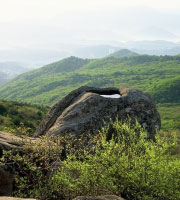 |
Cheongnyong-dong San 2-1 |
Mt. Geumjeongsan Geumsaem Spring |
- | According to Dongnae-hyeon Sancheonjo of Dong'guk Yeoji Seungram Volume 23 regarding Geumsaem Rock which sits on top of Mt. Geumjeongsan, “There is a well on a ridge, where a gold-colored fish leisurely swam after it had descended from the sky riding a five-colored cloud”. After that, the mountain was named Geumjeongsan. |
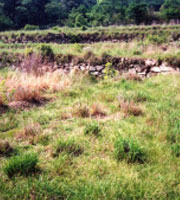 |
Geumseong-dong 22-2 |
Site of Haewolsa Temple (海月寺址) |
Joseon period | Haewolsa Temple is a military temple where 100 Buddhist monks (76 from Beomeosa Temple, 18 from Gukcheongsa Temple, and 8 from Unsusa Temple) defended the inside fortress of Geumjeongsanseong Fortress (North Gate to West Gate). This temple lay near the Busan Students Educational Institute but merely its site remains today after it perished because of termites called bindae. Thus, the site is today called bindae jeolteo (temple site). |
 |
Cheongnyong-dong San 2-1 |
Gyemyeongbong Peak Beacon Fire Station |
Joseon period | Gyemyeongbong Peak (646m) has an unhampered view all around. Hwangnyeongsan Mountain comes into full sight to the south and to the north is Wonjeoksan Mountain clearly visible within a stone's throw.This may have been a small fortress composed of reinforcing stone walls but now only a circular site, which is thought to have been used to make a fire, has been restored by remodeling the walls. |
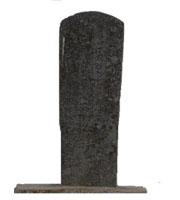 |
Dugu-dong 1117 |
Stone Monument for Jo Jeongeon | 1827 | This monument built next to a lotus marsh in 1887 was intended to honor the meritorious deed of Mun Eung-bin and Song I-hu who turned rocky barren fields in Seokjeonpyeong, Joseongwon, Dugu-dong into fertile lands by creating a marsh.Thus, this is an important stone monument that evidences the history of the creation of the marsh near here. |
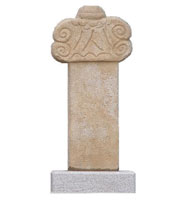 |
Seon-dong 900-3 |
Hwangsan Ibang (mandarin) Choi Yeon-su Stone Monument for honoring the Charity |
Joseon period | This was to honor the virtuous conduct of Ibang Choi Yeon-su who took care of soldiers when working in Husanyeok and Sosanyeok. |
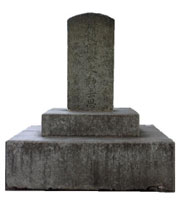 |
Bugok-dong 255-8 |
Dongnae Magistrate Min Yeong-hun Stone Monument for Honoring the Meritorious Deed |
Joseon period | This was built along the boundary line between Nopo-dong and Sasong Village, Yangsan, in 1838 (4th year of King Heonjong) in order to honor the meritorious deed of Dongnae Magistrate Min Yeong-hun, who saved many people during a severe draught in Yangsan and so doing a benevolent deed for the people. The original stone monument was relocated to the mini-park in Bugok-dong when a new monument was set up there. |
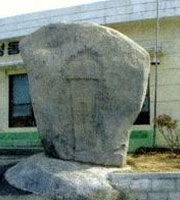 |
Geumseong-dong |
Byeoljang Kim Si-do Memorial Stone for Honoring |
Joseon period | People set up a memorial stone at the entrance to the government office in Biseokgol Village in 1907 in order to pay a tribute to the good deed of Byeoljang Kim Si-do who stipulated exemption from the land and farmland taxes. |
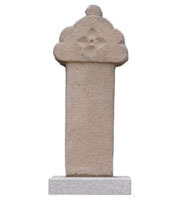 |
900-3, Seon-dong |
Secret Royal Inspector Yi Man-jik Memorial Stone for Honoring |
Joseon period | This stone was set up to honor the virtue of Secret Royal Inspector Yi Man-jik who raised a welfare fund for the livelihoods of the impoverished public in Sosanyeok. |
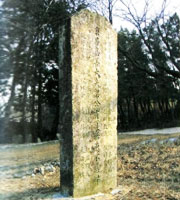 |
Nopo-dong 1102-1 |
Yang Yu-ha Memorial Stone for Honoring Kindness |
Joseon period | People in Dongnae and Yangsan set up a memorial stone together on Jigyeong Hill in 1735 in order to honor the kindness and virtue of Yang Yu-ha, who usually strived to give crops to people and hold a memorial service for ancestral spirits during the extremely lean years (1731-1733). |



